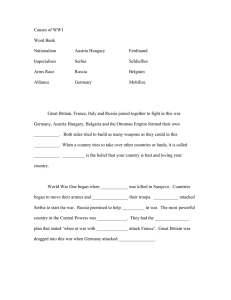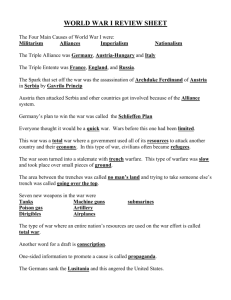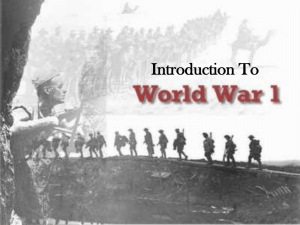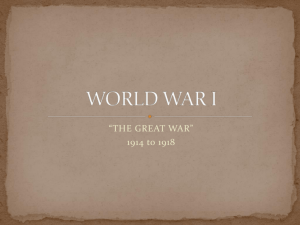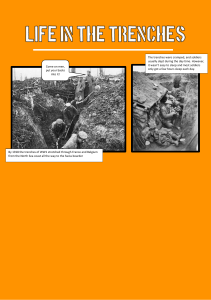Kami Export - Gabrielle Carpio - Crash Course World History-World War I
advertisement
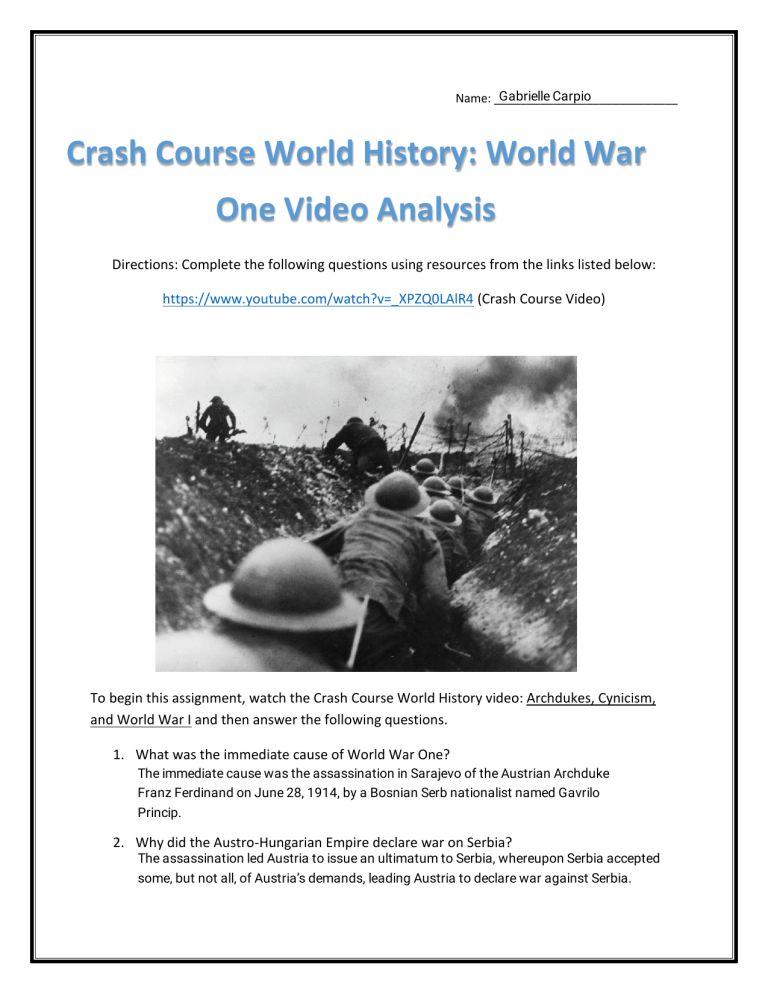
Gabrielle Carpio Name: ____________________________ Crash Course World History: World War One Video Analysis Directions: Complete the following questions using resources from the links listed below: https://www.youtube.com/watch?v=_XPZQ0LAlR4 (Crash Course Video) To begin this assignment, watch the Crash Course World History video: Archdukes, Cynicism, and World War I and then answer the following questions. 1. What was the immediate cause of World War One? The immediate cause was the assassination in Sarajevo of the Austrian Archduke Franz Ferdinand on June 28, 1914, by a Bosnian Serb nationalist named Gavrilo Princip. 2. Why did the Austro-Hungarian Empire declare war on Serbia? The assassination led Austria to issue an ultimatum to Serbia, whereupon Serbia accepted some, but not all, of Austria’s demands, leading Austria to declare war against Serbia. 3. Which nation mobilized its armed forces in order to defend Serbia? Russia mobilized its armed forces in order to defend Russia 4. Which nation mobilized its armed forces to help defend its ally Austria? Germany mobilized its armed forces to help defend its ally Austria. 5. Following its mobilization, what did Germany do? They declared war on Russia, then Germany cemented an alliance with the Ottomans, and declared on France. 6. What was the Schlieffen Plan? Germany’s War plan, the Schlieffen Plan, required that it invade France by going through Belgium. 7. How did Great Britain get involved in the war? Since Germany was now invading Belgium, Great Britain was allies with the Belgians forcing a declaration of war against the Germans. 8. By what date were all of the major European powers officially at war? What other world power sided with Britain and declared war on Germany? By August 4th, all the major powers of Europe are at war with each other. By the end of the month, Japan, honoring its alliance with Britain, would be at war with Germany. The military alliances of Europe in 1914 when war broke out- Italy was allied to Germany and AustriaHungary but declared neutrality at the outbreak of hostilities. Italy would join the allies later in the war. 9. What was the belief regarding war amongst nations at the outbreak of World War One? The cultural belief that war was, in general, good for nations. War helped define who was "them" and who was "us", and doing that strengthened the idea of us. And before World War I, war was perceived to be necessary and often even glorious. 10. What kind of warfare occurred on the Western Front during World War 1? The trench warfare on the Western Front is most famous for its brutal futility - GreatBritain and France on one side, Germany on the other, with no man’s land between. World 11. How extensive were the trenches on the Western Front? The lines of trenches on the Western Front covered only about 400 miles as the crow flies, but because of the endless zigzagging, the trenches themselves may have run as much as 25,000 miles. 12. Was the entire war dominated by trench warfare? Explain. Trench warfare wasn’t seen on every front. Especially at the beginning of the war, there was a lot of offensive movement, especially in the initial German strikes, especially on the Eastern Front, the Germans were pretty successful against the Russians, who had a large but pretty hapless army. 13. How did World War One involve combatants from all over the world? Britain’s army, especially, included soldiers from India, Africa, Australia, New Zealand, and Canada, who was just happy to be invited. Africans served with the French, and for a lot of these people, their experiences helped build nationalist movements when survivors returned home after the war. 14. How many casualties did World War One cause? How were France’s demographics especially devastated? Over 15 million people were killed and over 20 million wounded. In France, 13.3% of the male population between the age of 15 and 49 died in the war. The war also saw a lot of civilians die, especially in the Ottoman Empire where more than 2 million of the 3 million people killed were non-combatants. 15. What was the most efficient cause of death in World War One? World War I’s most efficient killer was disease 16. Why was the influenza epidemic in the closing stages of the war so devastating? The influenza epidemic broke out toward the end of the war, which killed three times as many people as the war itself. 17. Why was the actual warfare of World War One so deadly? The main reason the war was so deadly was the combination of new technology and outdated tactics. 18. Which new technologies were used as weapons in World War One? Which were the deadliest? Tanks, airplanes and poison gas made their debut the two most devastating technologies were American: machine guns and barbed wire. Attempting to march in lines towards an enemy’s trench, soldiers of both sides were mowed down by machine gun fire. 19. How many casualties did the British sustain on the first day of the Battle of the Somme? Why were the casualties so high? With the use of machine guns, at the Somme, the British lost 60,000 men in the first day of fighting. Canadian soldiers advancing through no man’s land towards the German trenches- notice the barbed wire that had to be scaled during the advance. 20. What was life like living in the British trenches? For the British, for example, the trenches were two things above all: wet and smelly. The dampness came from the fact that the British trenches were in the wettest part of Flanders. The smell was mainly decomposing flesh. On the upside, soldiers were at least rarely hungry, and there was a lot of food from home, which is worth underscoring, because it reminds us that home wasn’t very far away. Even for the British, at their closest the front was only 70 miles from England. They could read newspapers from Londo 21. What did it mean to go “over the top?” It is when going “over the top” of the trench to cross no-man’s land and attack the enemy trench. 22. What fear dominated the lives of soldiers living in the trenches? Most soldiers’ lives were dominated by the fear of shelling. 23. Why did soldiers continue fighting, even though the conditions were terrible and they were payed very little? Duty, nationalism, loyalty to comrades, and fear of being shot for desertion all played a role. Alcoholism also played a role in the persistence of fighting. 24. What treaty brought an end to World War One? Which nation was assigned blame? The Treaty of Versailles, which ended World War I, fixed the blame for the war on Germany, which proved ruinous to the German economy and destructive to its political institutions. 25. Why was World War One disastrous for Russia? Which group seized power? World War I was also a disaster for Russia, because it facilitated the rise of the Bolsheviks. 26. What were the two phases of the Russian Revolution? The Russian Revolution had two phases. In the first phase, called the February Revolution, army mutinies and civil unrest forced the overthrow of the Romanov dynasty. The monarchy was replaced by a provisional government led Alexander Kerensky, which made the terrible decision to keep Russia in the war, which led to the October Revolution, in which Vladimir Lenin and his Bolsheviks took over, famously promising the Russian people “peace, bread, and land.” 27. What was Lenin’s first big achievement as Russia’s new leader? Lenin’s first big achievement was signing a separate peace with Germany and getting Russia out of the war, which was helpful to him since he needed to fight a civil war that wouldn’t end until 1922. 28. Why was Germany not able to exploit the manpower advantage they gained from only having to fight on one front after Russia left the war? This might’ve helped Germany, too, except the US entered the war on the side of the British and the French. 29. How did the United States benefit from World War One? The United States benefitted by increased geopolitical influence for the U.S. The U.S. was already becoming a major economic power, and being able to avoid the destruction and loss of manpower associated with World War I certainly didn’t hurt. The war helped catapult the U.S. from being a debtor nation to a creditor one, and Wilson’s leading role in the negotiations at Versailles made America a big player on the world stage for the first time. 30. How did the world change outside of Europe following the war? Another major outcome of the war was the end of the Ottoman Empire and the emergence of the nation-state of Turkey. In Africa, Britain took Germany’s colonies, and even though Indians fought and died in a higher percentage than Americans in World War I, India didn’t gain any real autonomy.

